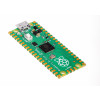Challenger RP2040 LTE MkII
Delivery Time: ab Lager
Verfügbarkeit: Zur Zeit nicht an Lager
The Challenger 2040 LTE is an Arduino/Micropython compatible Adafruit Feather format micro controller board based on the Raspberry Pico chip.
The new MkII version has an improved power supply section that reduces power consumption and allows the board to run at a lower battery voltage than before. Which in the end leads to longer battery operating time.
This board has been designed to allow you as a user to be able to create inexpensive IoT devices that can be deployed anywhere without having to depend on a WiFi-connection or to have a Phone with a bluetooth connection open. This just works wherever you are. It connects seamlessly to the same network that you phone does and allows you to transfer your data quickly and with very short delays.
And by using the powerful dual core RP2040 combined with 8Mbyte of flash memory you get a device that can handle pretty much anything you can trow at it. For instance if you let one core handle the LTE modem and the second core do all the UI stuff you get an extremely responsive system. Not to mention that the 8MByte of FLASH memory will let you install any (or all) circuitpython support libraries that you will every need.
Microcontroller
Again we have used the popular RP2040 from the Raspberry Pi Pico. An extremely well suited embedded processor for doing cool projects and managing high end communication devices such as the embedded modem. With its dual core Cortex M0 at 133MHz, 8 MByte of FLASH and 264 Kbyte of integrated RAM it will take a very long time before you run our of resources.
LTE (Cat M1/NB-IoT)
The module we selected to handle the cellular communication is the SARA-R410M series module. This module can be software multi-band configured, enabling international multi-regional coverage in LTE-M/NB-IoT radio access technologies.
The SARA-R410M module is ideal for mission critical IoT solutions, as it includes a unique and immutable root of trust. It supports IoT security as a service and provides the foundation for a trusted set of advanced security functionalities. The scalable, pre-shared key management system offers data encryption and decryption, both on-device as well as from device to cloud. Utilizing the latest (D)TLS stack and cipher suites with hardware based crypto acceleration provides robust, efficient and protected communication.
Communication with the modem device is done over the second serial port of the RP2040 and the board is configured for hardware flow control which allows you to use high data transfer speeds to and from the modem.
The supplied cellular antenna is connected to the board through a U.FL connector at the rear of the board. The antenna can then be attached to a plastic enclosure by peeling of the protective film and pressing it in place.
SIM Card
The board needs a nano SIM card in order to be able to connect to an LTE network and transfer data. Here you can either get it yourself or use our prepaid cards from 1NCE. The IoT pricing of the 1NCE IoT Flat Rate contains 10 years of connectivity services for 150 SEK. It is a one-time-payment only with no hidden costs. 1NCE offers one IoT data plan where all necessary features are included:
- 500 MB data volume with speeds up to 1Mbit/s
- 250 SMS
- SIM card
- Global coverage in 130+ countries (Check if your country is covered here)
- All mobile standards (2G, 3G, 4G, LTE-M, NB-IoT)
- IoT Connectivity Management Platform
- REST API
- APN
- OpenVPN
- Connectivity Suite
- Customer Service
1NCE also offers a top-up option in the event that your use case demands more data volume. You can either set the top-up option yourself or the automatic top-up option in the customer portal.
Buttons
There are two buttons on the board. The button closest to the USB connector is the reset button. Use it whenever you need to reset the unit. It has exactly the same functionality as the RESET pin. Then there is the BOOT button just next to the reset button. This button must be used in conjunction with the reset button to reset the RP2040 into UF2 mode. Press the BOOT button, then the RESET button for a short moment. Then release the RESET button (while still pressing the BOOT button) and shortly after that release the BOOT button. This will place the board in UF2 mode and show up in the computer as a mass storage device.
USB Type C
In the recent years we have noticed that we are seeing more and more USB Type C cable laying around the lab due to the fact that all new phones and accessories use them. As of yet we haven’t seen any shortage of micro USB cables but we are not getting any new ones any more and old ones do break occasionally. So we decided to go for a USB Type C connector for this board. A bonus of this is that they are quite bit more durable and you don’t have to fiddle with the cable before plugging it in








